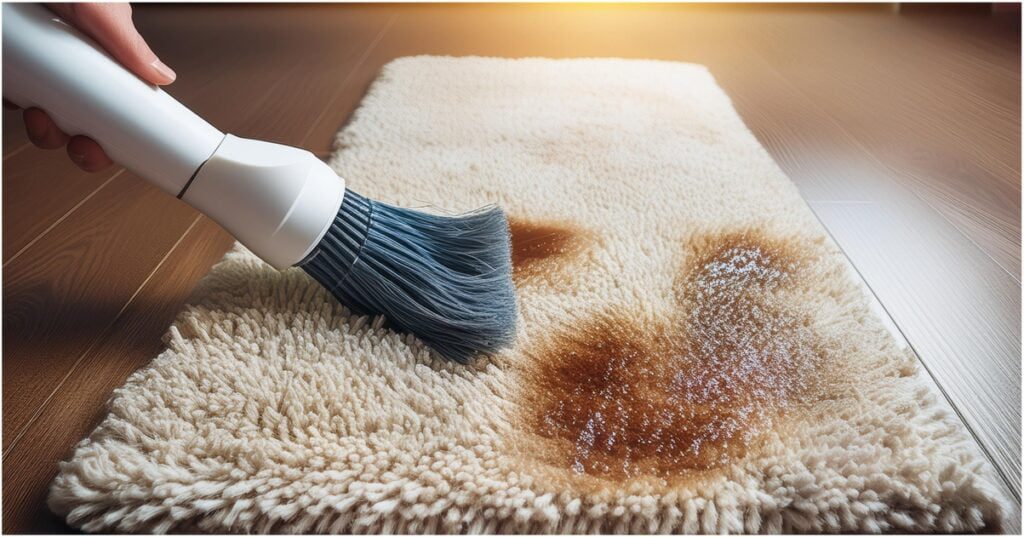How to Remove Carpet Stains - The Stain Removal Guide

Introduction: The Challenge of Carpet Stains
Carpet stains are an inevitable part of life, whether from spills, accidents, or daily wear and tear. They can be particularly challenging to deal with due to their ability to set quickly and penetrate deep into carpet fibers. This guide aims to provide you with practical steps and tips to effectively remove common carpet stains and keep your carpets looking clean and fresh.
Step 1: Act Quickly
Importance of Immediate Action
When a spill occurs, time is of the essence. The quicker you act, the less likely the stain will set and become permanent.
Basic Steps to Take Immediately
- Blot the Spill: Use a clean cloth or paper towel to blot (not rub) the spill. This helps absorb the liquid without spreading it further.
- Remove Solid Debris: If there are any solid parts, gently lift them away with a spoon or dull knife.
Step 2: Gather Your Cleaning Supplies
Essential Stain Removal Tools and Products
- Clean Cloths or Paper Towels
- Soft-Bristle Brush
- Spray Bottle
- Vacuum Cleaner
- Mild Dish Soap
- White Vinegar
- Baking Soda
- Hydrogen Peroxide
- Commercial Carpet Cleaner (optional)
Recommendations for Effective Cleaning Solutions
- Vinegar and Water: Mix one part white vinegar with one part water.
- Dish Soap Solution: Mix a few drops of mild dish soap with water.
- Hydrogen Peroxide Solution: Use hydrogen peroxide for tougher stains, but test in an inconspicuous area first.
Step 3: Blot, Don’t Rub
Why Blotting is Preferred Over Rubbing
Blotting helps to absorb the liquid and prevent the stain from spreading or pushing deeper into the carpet fibers.
Techniques for Blotting Different Types of Stains
- Liquid Stains: Blot gently from the outside in to avoid spreading.
- Solid Spills: Remove solids first, then blot the remaining liquid.
Step 4: Identify the Type of Stain
Categorizing Stains
- Food and Drink Stains: Coffee, wine, juice, sauces.
- Oil-Based Stains: Grease, makeup, lotions.
- Pet Accidents: Urine, feces, vomit.
- Miscellaneous: Ink, mud, blood.
Determining the Appropriate Cleaning Method
Different stains require different cleaning approaches. Understanding the type of stain helps in selecting the right cleaning solution and technique.
Step 5: Apply the Right Cleaning Solution
Common Household Stain Removers
- Vinegar and Water Solution: Effective for many types of stains.
- Dish Soap Solution: Good for grease and food stains.
- Baking Soda Paste: Ideal for deodorizing and lifting stains.
- Hydrogen Peroxide: Strong cleaner for tougher stains, use with caution.
Step-by-Step Guide for Using Specific Solutions
- Vinegar Solution: Spray the solution onto the stain, let it sit for a few minutes, then blot with a clean cloth.
- Dish Soap Solution: Apply the solution, gently scrub with a soft-bristle brush, then blot.
- Baking Soda Paste: Apply the paste, let it dry, then vacuum.
- Hydrogen Peroxide: Apply, let it sit for a few minutes, then blot and rinse.
Step 6: Work the Solution into the Stain
Techniques for Working the Cleaning Solution into the Carpet Fibers
- Use a Soft-Bristle Brush: Gently scrub in a circular motion.
- Blot with a Cloth: After applying the solution, blot to lift the stain.
Tips for Using Brushes, Cloths, and Other Tools Effectively
- Use Gentle Pressure: Avoid damaging the carpet fibers.
- Repeat as Necessary: Some stains may require multiple applications.
Step 7: Rinse and Blot Dry
Importance of Rinsing the Area
Rinsing helps to remove any residual cleaning solution, which can attract dirt if left in the carpet.
Best Practices for Blotting the Carpet Dry
- Use a Clean Cloth: Blot the area with a clean, dry cloth.
- Avoid Over-Wetting: Use minimal water to rinse.
Step 8: Repeat if Necessary
When and How to Repeat the Cleaning Process
- Persistent Stains: Some stains may need multiple treatments.
- Patience and Persistence: Allow time for the solution to work before repeating.
Step 9: Allow the Carpet to Air Dry
Methods for Ensuring the Carpet Dries Completely
- Ventilation: Open windows or use fans to increase air circulation.
- Dehumidifiers: Help to speed up the drying process.
Step 10: Vacuum the Area
Importance of Vacuuming the Carpet After It’s Dry
Vacuuming helps to restore the carpet’s texture and removes any remaining residue.
How Vacuuming Helps Restore the Carpet’s Texture and Appearance
Regular vacuuming keeps the carpet fibers upright and looking fresh.
Special Tips for Specific Stains
Techniques for Removing Common Stains
- Wine: Blot with a mixture of water and dish soap.
- Coffee: Use a vinegar solution.
- Pet Urine: Apply a mixture of vinegar and baking soda, then vacuum.
- Grease: Use a dish soap solution.
Homemade vs. Commercial Stain Removers
- Homemade: Effective for most stains and eco-friendly.
- Commercial: Useful for particularly stubborn stains or specific types.
Preventative Measures
Tips for Preventing Future Stains
- Use Rugs: Place rugs in high-traffic areas.
- Immediate Clean-Up: Address spills as soon as they occur.
- Carpet Protectors: Apply to prevent stains from setting.
How to Apply Carpet Protectors and Their Benefits
- Spray Evenly: Follow the product instructions.
- Regular Application: Reapply every few months for best results.
Conclusion: Keep Your Carpet Looking New
By following these steps, you can effectively remove most carpet stains and maintain the appearance of your carpets. Regular cleaning and immediate action on spills are key to keeping your carpets looking new. Remember, the quicker you address a stain, the easier it is to remove. Happy cleaning!
